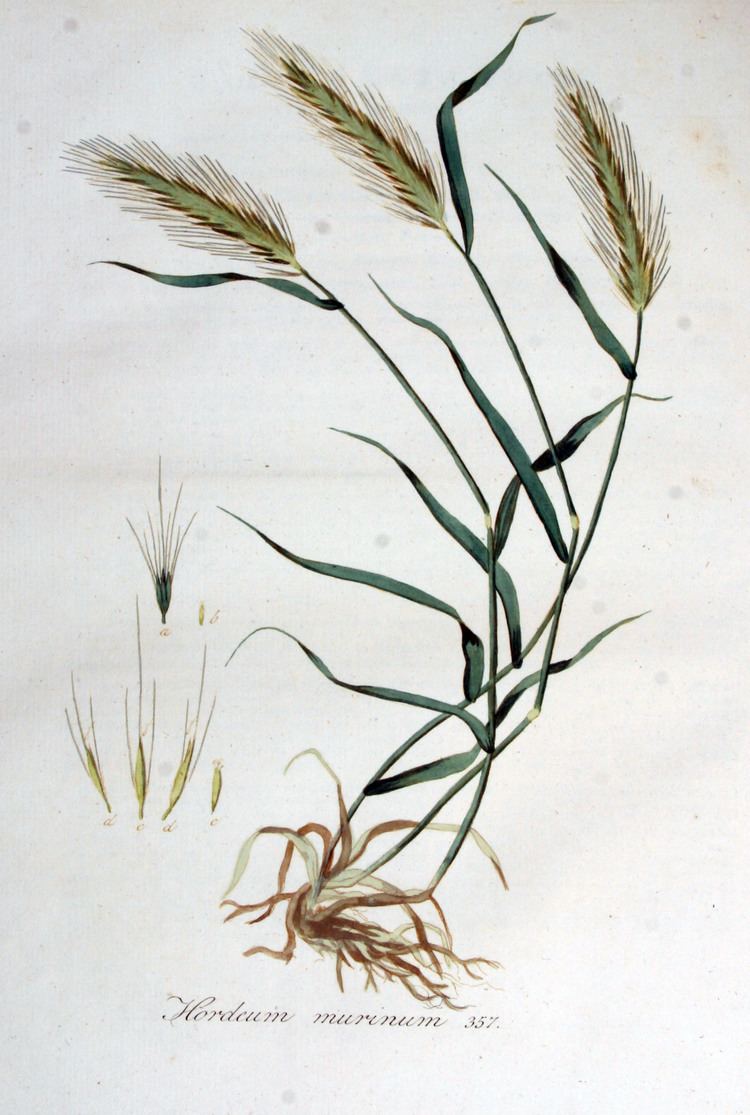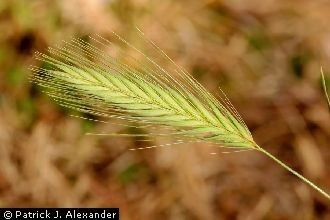Genus Hordeum Higher classification Hordeum | ||
 | ||
Similar Hordeum, Grasses, Hordeum marinum, Bromus sterilis, Bromus hordeaceus | ||
Hordeum murinum, commonly known as wall barley or false barley, is a species of grass.
It can grow to 30 cm in height and its unbranched spikes can reach 10 cm long. It is quite widespread and common. It flowers during May through July in mainly coastal areas. It produces small, dry nutlets and its leaves can be 8 mm wide with short, blunt ligules.

In the United Kingdom it is absent throughout most of Ireland and Scotland but is common in England and Wales.

Subspecies include ssp. leporinum, known as hare barley, mouse barley, and barley grass. It grows in tufts from 10 to 40 centimetres in height. It was first published as the full species Hordeum leporinum by Johann Heinrich Friedrich Link in 1834. In 1882 it was redescribed as a subspecies of H. murinum by Giovanni Arcangeli. Today some authorities maintain it at the species level. It is native to Europe, northern Africa and temperate Asia, and it is widely naturalised elsewhere. Barley grass is known in Chinese as màiqīng (麦青) and is a common ingredient in the spring snack qingtuan.

Hordeum murinum is an annual winter species whose seeds germinate and develop in the spring. It is also referred to as wall barley and are tetraploids. It is distinct from other species of the genus because of its morphology and molecular genetics. It is also distinct because of the barriers it has with the Hordeum taxa when it comes to its ability to cross with it.

Growth Requirements
Hordeum murinum complex is the most widespread of all the other Hordeum species. The center of distribution of Hordeum murinum is in the Mediterranean area, Central Europe, Western Asia, and North Africa. A greater quantity of dry material is produced with medium precipitation and better distribution. Precipitation is the most important factor in the production of seeds for this species. In the years that are more dry with early or late rainfalls, there is no chance of re-seeding for this species. The species uses a greater part of its reproductive resources for seed production, allowing it to adapt to different water conditions. Controlling the seeding rate favors high-quality strand of barley. The sowing rate for wall barley increases when seed production and forage increases. This helps to obtain ideal and sustainable forage and seed yield in rangelands of Jordan. The height of the plant and protein content does not respond to seeding rates, but the height of the plant and protein content does vary with years. Anatomical characteristics of leaf blades differ between the taxa. This weedy species along with hare barley and smooth barley can be hard to control.

Subspecies
Hordeum leporinum is a subspecies of Hordeum murinum. It is also known as hare barley. Hordeum leporinum is found in the Mediterranean region near continental, oceanic, and colder climates. The flowers of this is attached to branches rather than to the main axis. Another subspecies of Hordeum murinum is Hordeum glaucum. It appears in warmer climates of the Mediterranean region. Hordeum leporinum is a more dominant species in areas where the rainfall is greater than 425 mm. Hordeum glaucum is more dominant in semiarid regions where rainfall is less than 425mm. Hordeum leporinum and Hordeum glaucum differ primarily because of their chromosome numbers, spikelet morphology, and geographical distribution. Within Hordeum, there are 2 subgenera and 4 sections with 4 different genotypes. The clade that is the sister taxon to Hordeum murinum is H. bulbosum and H. vulgare.

Uses
Weedy barley species is an important component of annual pastures. This is useful for feeding grazing animals and useful for us because we then eat these animals. It is also the main source of forage for cattle production in areas with water deficits. Hordeum murinum is any economically important cereal crop in the tribe Triticea.They use the seed part of Hordeum murinum and ground it into a flour. This is then used to make bread or porridge.
